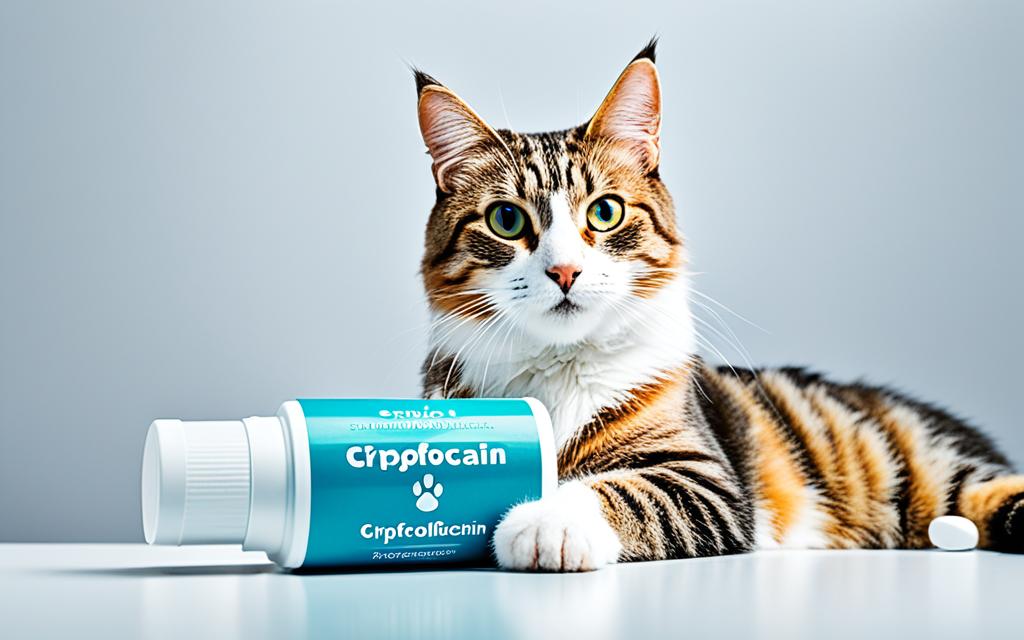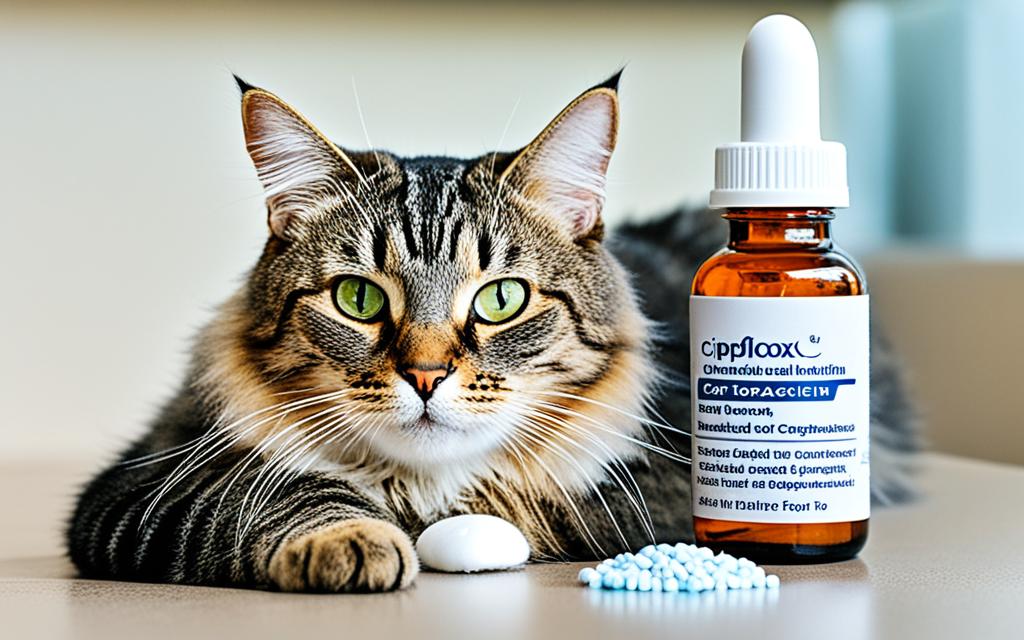Ciprofloxacin for cats: Uses, Dosage & Side Effects Guide
Did you know that ciprofloxacin comes in many tablet sizes, making it useful for cats1? Veterinarians often prescribe this broad-spectrum antibiotic. It’s great for fighting different bacterial infections in cats.
Ciprofloxacin, or Cipro, fights infections in cats caused by certain bacteria2. It falls within the fluoroquinolone antibiotic category. This means it stops the DNA process in bacteria, halting their spread.
Key Takeaways
- Ciprofloxacin is a broad-spectrum antibiotic used to treat bacterial infections in cats.
- It is available in a range of tablet sizes, from 100 mg to 750 mg, providing flexible dosing options.
- Ciprofloxacin is classified as a fluoroquinolone antibiotic and works by disrupting bacterial DNA.
- Cipro is FDA-approved for treating various infections in cats, including urinary tract, respiratory, and skin infections.
- Potential side effects in cats may include diarrhea, nausea, and liver damage with long-term use.
Table of Contents
What is Ciprofloxacin?
Ciprofloxacin is a common antibiotic for humans3. But it’s not widely used for cats, unlike drugs such as Amoxicillin and Clindamycin3. Vets usually choose other antibiotics for treating cats3.
Brand Names and Other Names
In humans, it’s known as Cipro®, Ciloxan® (eye drops), and Cetraxal® (ear drops)4. But there’s no FDA-approval for its use in cats4. Vets have to use it as a special or extra drug for animal treatment4.
How Ciprofloxacin Works
Ciprofloxacin is a type of antibiotic that fights bacteria4. It stops the bacteria from making DNA, which they need to grow and spread4. Because of this, it can help with a lot of bacterial infections4.
It comes in different strengths as tablets: 100 mg to 1000 mg5. For animals, Enrofloxacin is the more common choice5. Both Ciprofloxacin and Enrofloxacin are used to fight off certain infections, especially those caused by Pseudomonas5.
For people, Ciprofloxacin changes into Enrofloxacin in the body5. In cats, it’s not the first choice for antibiotics3. Vets usually pick from several other drugs for treating cats34.
Ciprofloxacin for cats
While the FDA doesn’t approve ciprofloxacin for animal use, including cats, vets may still use it. They do this to treat bacterial infections in cats when they think it’s best. Ciprofloxacin is known for human use with brand names like Cipro®, Ciloxan®, and Cetraxal®. But, it’s not made for animals4.
Vets might use ciprofloxacin in cats even though it’s not specifically for them4. They will do this if other medicines aren’t suitable. This is commonly seen in pets with unique needs or who can’t take pills4.
Ciprofloxacin stops bacteria from making DNA. This stops the bacteria from growing. But, it can cause some side effects in pets, like stomach problems, or even more serious reactions4.
Letting a vet oversee any ciprofloxacin treatment in cats is crucial. They will tell you how much and when to give the medicine. If a cat takes too much ciprofloxacin, get them to a vet right away4.
Keep ciprofloxacin in a cool, dry place. Always follow your vet’s advice when giving it to your cat. They will make sure it’s used safely and correctly4.
Ciprofloxacin can be used in dogs and cats with certain infections, although it may not always work well. How well it works can change. This is because not all of the medicine is taken up by the body6.
The dose of ciprofloxacin might change depending on how well the pet’s body absorbs it. It’s used for infections that are hard to treat, or when IV meds are needed. Your vet will need to give you a prescription for ciprofloxacin6.
Give ciprofloxacin to your pet on an empty stomach. Wait at least 2 hours before giving any dairy products or antacids. This helps the medicine work better6.
Ciprofloxacin comes in different tablet strengths. An important thing to remember is that it’s for human use. But, the body changes it into a form animals can use5.
Pets can react differently to ciprofloxacin. Some might eat less, throw up, or have diarrhea. We see this medicine can also hurt the joints of very young dogs5.
Giving ciprofloxacin to cats might cause blindness over time. It might also make seizures more likely. And sometimes, it can lead to bladder stones. Always be careful with this medicine and follow your vet’s advice5.
It’s important not to mix ciprofloxacin with certain other medicines. This includes things like antacids, and drugs for organ transplants. Some medicines need their doses to be adjusted if taken with ciprofloxacin5.
Take care with ciprofloxacin around pregnant animals, or young dogs. Usually, it shouldn’t be used in them. But, there are times when the vet might decide it’s the best choice5. In severe ear infections in dogs, which might be expensive to treat, higher ciprofloxacin doses could be needed46.
Uses of Ciprofloxacin for Cats
Bacterial Infections Treated with Ciprofloxacin
Ciprofloxacin, also known as Cipro®, is an antibiotic for cats. It can treat bacterial infections in cats. These infections are often in the urinary tract or on the skin7. It might not get absorbed as well as some other medicines. But, it usually starts helping within 1 to 2 hours after taking it. People usually see their pets getting better within two days of starting this medicine7.
Cats might get this medicine for bladder infections or other types. They usually need more of the medicine to work because their bodies can’t absorb it well. Sometimes, veterinarians might prescribe it for other bacterial infections4. But remember, it’s not approved by the FDA for animals. It’s either used off-label or in special forms agreed on by a vet for certain cases4.
The medicine helps with several bacterial infections in cats. These include skin, urinary tract, respiratory, and wound infections7. But, it doesn’t work against viruses, parasites, or fungi. So, it’s only for treating bacterial infections7.
Ciprofloxacin is helpful but needs to be used carefully in cats. It can cause stomach problems, issues with peeing, anxiety, and allergies7. Be careful with young cats because it might cause problems with their cartilage7. If your cat has liver or kidney problems, be extra cautious. Always let your vet know about such issues7.
“Ciprofloxacin should not be used in young, growing pets, dehydrated pets, those hypersensitive or allergic to quinolone antibiotics, or in pregnant animals due to concerns about cartilage damage.”7
Also, ciprofloxacin can affect how some other medicines work. This includes things like antacids, corticosteroids, and cyclosporine7. Always tell your vet about every drug, vitamin, supplement, or herb your pet takes754.
Administering Ciprofloxacin to Cats
Dosage and Frequency
Ciprofloxacin is given to cats at 10 to 12.5 mg per pound, once a day. Your vet might split this up, giving half in the morning and half at night. They’ll decide the best dose based on your cat’s health and how they respond.
Directions for Use
It’s usually better to give Ciprofloxacin to cats when their stomachs are empty. If your cat feels sick after taking it, you can give the next dose with a little food. Always follow your vet’s advice on how to use this medicine.
Ciprofloxacin is a type of medicine that needs a prescription. It’s an antibiotic used in pets, including dogs and cats, to fight certain bacterial infections. If the usual Ciprofloxacin medicines aren’t right for your pet, the vet might suggest special versions that match your pet’s unique needs.
| Dosage Instructions | Details |
|---|---|
| Bacterial Conjunctivitis | Adults and children 2 years and older: Use a ½-inch strip of eye ointment in each eye 3 times a day for the first 2 days, then 2 times a day for the next 5 days8. Infants and children up to 2 years: Dosage based on individual needs and conditions as determined by a doctor8. |
| Bacterial Conjunctivitis (Ophthalmic Solution) | Adults and children: Put 1 or 2 drops in the affected eye every 2 hours for 2 days, then every 4 hours for the next 5 days8. |
| Corneal Ulcers | Put 2 drops in the affected eye every 15 minutes for the first 6 hours on day 1, then every hour on day 2, and every 4 hours from days 3 through 148. |

The dosing info in the table is meant for humans, not cats. Remember, always talk to your vet about the right way to give Ciprofloxacin to your feline friend.
Precautions and Side Effects
Ciprofloxacin can be safe for cats, but it may lead to side effects9. Some cats might experience problems with their stomach like vomiting, diarrhea, and not wanting to eat. More serious issues could show up too, such as urinary crystals, bladder stones, or feelings like having a seizure9. There’s a chance of allergic reactions too9.
Potential Side Effects
In cats, ciprofloxacin’s main effects are on the stomach, often causing vomiting or diarrhea9. Cats might also experience eye troubles, including pain, redness, itching, tears, and vision changes9. Sometimes, it can leave a bad taste in their mouths. After starting, some may see crystals in their eyes, but those usually go away soon9. There’s also a small risk of allergic reactions, like trouble breathing9.
Risk Factors and Contraindications
Avoid giving ciprofloxacin to young cats still growing because it could harm their cartilage9. It’s also risky for cats with a history of seizures or those with bad kidney or liver problems9. Pregnant or nursing cats shouldn’t use it either. It’s because the dangers might be more than any help it gives9. Don’t give it to cats if they are known to react badly to ciprofloxacin or similar drugs9.
| Potential Side Effects | Risk Factors and Contraindications |
|---|---|
| Vomiting Diarrhea Loss of appetite Urinary crystals Bladder stones Neurological symptoms (e.g., seizures) Allergic or hypersensitivity reactions Eye pain, redness, itching, tearing, blurry vision Bad taste in the mouth | Young, growing cats (risk of cartilage damage) Cats with a history of seizures Cats with severe kidney or liver disease Pregnant or lactating cats Cats with known hypersensitivity or allergy to ciprofloxacin or other fluoroquinolone antibiotics |
Keep a close eye on your cat during ciprofloxacin treatment for any negative signs or lack of progress9. If their eyes seem cloudy or they’re not getting better after 7 days, stop the treatment and get in touch with the vet9.
“Ciprofloxacin should be used with caution in young, growing cats due to the risk of cartilage damage.”
Drug Interactions
Ciprofloxacin is a common antibiotic for cats, but it can interact with many other drugs10. This means the treatment might not work well or could even be unsafe. It’s key for cat owners to tell their vet about all other medications and supplements their cat uses10.
Antacids, iron supplements, and other medications can mix badly with ciprofloxacin10. To avoid problems, don’t give these substances to your cat close to when they take ciprofloxacin. This timing helps the antibiotic to work right10.
Drinking alcohol, or using caffeine or tobacco while your cat is on ciprofloxacin can cause more side effects11. To prevent issues, always listen to your vet’s advice. This will make sure ciprofloxacin is safe and does its job well in your cat10.
Remember, knowing about these interactions and sharing your cat’s full medication list with the vet is crucial10. This way, treatment with ciprofloxacin can be safe and effective. Keep your cat’s healthcare team informed10.

Drug interactions can be serious, but how they affect your cat can differ10. Always follow your vet’s advice on managing these potential problems. Your vet will guide you to keep your cat safe while being treated101211.
Monitoring and Storage
When giving ciprofloxacin to cats, you normally don’t need to check anything special13. But, a vet might want to see how your cat is doing on the medicine. This is especially true for cats with liver or kidney issues already13.
Monitoring Required
Ciprofloxacin may affect how the liver and kidneys work13. Because of this, a vet could ask for blood tests now and then. These tests help make sure your cat is safe and the medicine is working right13.
Proper Storage
Store ciprofloxacin tablets in a tight container below 86°F (30°C) and away from UV light13. Follow any specific storage info for liquid forms. And remember, keep it away from kids or pets to avoid accidents13.
Stick to the guidelines for checking on and storing ciprofloxacin. This way, you’re looking after your cat’s health. Good storage also means the medicine stays strong and does its job well.
Comparison with Similar Antibiotics
Ciprofloxacin is an option for cat bacterial infections instead of the usual enrofloxacin (Baytril)4. Yet, its effectiveness in cats is still debated4. Some vets might choose enrofloxacin or other usual antibiotics instead4.
For years, chemicals like ciprofloxacin and enrofloxacin have treated urinary infections a lot14. Changing these chemicals’ structures gave us many effective germ killers14.
Flumequine, a different antibiotic, has helped with digestive infections in farm animals around the world14. Adding a special fluoro atom to these chemicals makes them fight more types of germs14.
Quinolones don’t mix well with water at certain pH levels, affecting how they work in the body14. Most quinolone medicines have to be put into liquid forms to work well, showing a usual way medicines are prepared14.
Vets have to carefully pick the right fluoroquinolone drug for each pet infection. They need to think about how each drug works and the risks involved15. Tests to see which drug is best are needed for UTIs15. The medicine has to get to the pee in enough amount to kill the germs15.
The choice between ciprofloxacin and enrofloxacin depends on the pet’s situation and the vet’s experience41415.
Missed Dose and Overdose Information
If you miss giving your cat ciprofloxacin, act fast but carefully. Give the dose when you remember, even if it’s a bit late16. Yet, if it’s almost time for the next dose, just move on without giving the missed one16. Don’t ever give two doses together. Extra doses might harm your cat.
Overdosing a cat with ciprofloxacin is rare but can happen. Signs of overdose could be dangerous. Contact your vet or a poison control center for animals immediately if you’re worried16. Quick treatment is key to avoiding bad effects of too much medicine16.
Always follow your vet’s exact directions for giving ciprofloxacin. Doing so makes sure it works right and keeps your cat safe16. Giving the medicine correctly and at the right amount helps your cat get better16.
“In case of a missed dose, it is recommended to administer it when remembered, but not to double dose.”
If you’re ever unsure about what to do with a missed dose or overdose, talk to your vet. They know what to do to protect your cat’s health and can offer the best advice.
Conclusion
Cipro (ciprofloxacin) works well against some cat infections, even though it’s not okayed by the FDA for pets17. Vets can use it under certain rules, giving human-labeled cipro to animals, thanks to AMDUCA17. But, it’s a must to stick to the vet’s plan on how to give it, the right amount, possible side effects, and anything that might not mix well with other drugs.
Research shows ciprofloxacin helps fight off infections in animals18. In a macaque study, every treated animal got better, no matter how long the treatment went on18. Cipro also did better than doxycycline in getting rid of bacteria still hanging around in the animals’ tissues18. While an illness like tularemia, which cipro treats, is rare in the U.S18., this data indicates it’s a good option for cat infections, according to the info.
Summing up, remember it’s crucial to listen to your vet about how to use ciprofloxacin. This antibiotic can do a lot of good for some cat infections18. And make sure to keep an eye on it and store it correctly. Knowing these facts aids in making the right choices for your cat’s health along with your vet.
FAQ
What is Ciprofloxacin?
How does Ciprofloxacin work?
Is Ciprofloxacin approved for use in cats?
What types of bacterial infections can Ciprofloxacin treat in cats?
What is the typical dosage of Ciprofloxacin for cats?
What are the potential side effects of Ciprofloxacin in cats?
Are there any contraindications or precautions when using Ciprofloxacin in cats?
Can Ciprofloxacin interact with other medications?
How should Ciprofloxacin be stored?
What should I do if I miss a dose of Ciprofloxacin for my cat?
Source Links
- Ciprofloxacin (Cipro®, Ciloxan®) for Dogs and Cats
- Cipro (ciprofloxacin): Side effects, dosage, uses, and more
- Common Antibiotics for Dogs and Cats
- Ciprofloxacin for Dogs and Cats
- CIPROFLOXACIN
- Ciprofloxacin (Generic)
- Ciprofloxacin – Oral | VCA Animal Hospitals
- Ciprofloxacin (Ophthalmic Route)
- Ciprofloxacin – Ophthalmic | VCA Animal Hospitals
- Possible drug–drug interaction in dogs and cats resulted from alteration in drug metabolism: A mini review
- Ciprofloxacin (Ophthalmic Route) Precautions – Mayo Clinic
- Ciprofloxacin (Ciloxan) ophthalmic: Uses, Side Effects, Interactions, Pictures, Warnings & Dosing – WebMD
- Microsoft Word – Fluoroquinolones Final 2007 2-column.doc
- Quinolones, Including Fluoroquinolones, Use in Animals – Quinolones, Including Fluoroquinolones, Use in Animals – Merck Veterinary Manual
- Use of Antibiotics for Treating UTIs in Dogs and Cats
- No title found
- Efficacy of Doxycycline and Ciprofloxacin for Treatment of Pneumonic Tularemia in Cynomolgus Macaques







